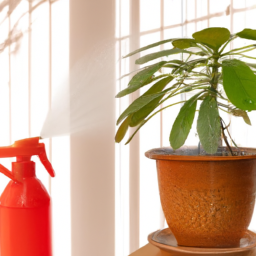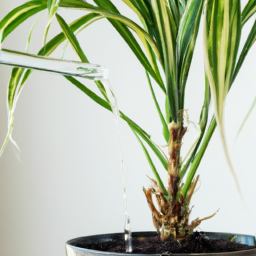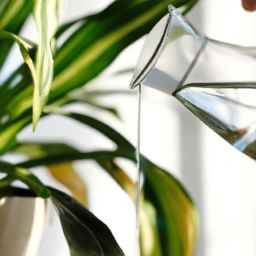
Are you struggling to keep your indoor plants healthy and thriving? One of the most important factors in maintaining happy houseplants is ensuring they are properly watered. In this blog post, we will discuss the best way to water indoor plants to help you keep your green friends looking their best. Proper watering techniques can make a big difference in the health and longevity of your indoor plants, so let’s dive in and learn how to keep them hydrated and happy!
Benefits of Using a Watering Schedule for Indoor Plants
Consistent Moisture Levels
Indoor plants thrive when they receive consistent moisture levels. By creating a watering schedule, you can ensure that your plants are receiving the right amount of water at the right time. This helps prevent overwatering or underwatering, both of which can be detrimental to plant health. Consistent moisture levels also help plants regulate their growth and development, leading to healthier and more vibrant foliage.
In addition, a watering schedule can help you identify any issues with your plants’ water needs. If you notice that a plant is consistently drooping or wilting, it may be a sign that it needs more frequent watering. On the other hand, if you see signs of root rot or yellowing leaves, you may be overwatering your plant. By following a watering schedule, you can easily adjust your watering routine to meet your plants’ needs.
Another benefit of using a watering schedule is that it can save you time and effort in the long run. Instead of constantly checking your plants for signs of dehydration or overhydration, you can simply refer to your schedule to determine when each plant needs to be watered. This can help streamline your plant care routine and ensure that your plants are always receiving the care they need.
Prevents Watering Mishaps
One of the biggest benefits of using a watering schedule for indoor plants is that it helps prevent watering mishaps. Overwatering is a common issue that can lead to root rot, mold growth, and other plant problems. By following a schedule, you can ensure that you are not watering your plants too frequently, allowing the soil to dry out between waterings.
Similarly, underwatering can also be harmful to indoor plants, causing them to become dehydrated and wilted. A watering schedule can help you avoid this issue by reminding you to water your plants regularly. This can be especially helpful for busy individuals who may forget to water their plants on a consistent basis.
Additionally, a watering schedule can help you avoid the temptation to water your plants based on their appearance alone. While it may be tempting to water a plant as soon as it starts to wilt, this can actually do more harm than good. By following a schedule, you can ensure that you are watering your plants based on their actual water needs, rather than their outward appearance.
Promotes Healthy Growth
Finally, using a watering schedule for indoor plants can help promote healthy growth and development. Consistent watering is essential for plant health, as it helps plants absorb nutrients and stay hydrated. By following a schedule, you can provide your plants with the water they need to thrive, leading to stronger roots, lush foliage, and vibrant blooms.
In addition, a watering schedule can help you tailor your watering routine to meet the specific needs of each plant. Some plants may require more frequent watering, while others may prefer to dry out between waterings. By creating a schedule that takes into account the individual needs of each plant, you can ensure that all of your indoor plants are receiving the care they need to flourish.
Overall, using a watering schedule for indoor plants is a simple yet effective way to promote plant health and ensure that your plants are receiving the care they need. By following a schedule, you can maintain consistent moisture levels, prevent watering mishaps, and promote healthy growth, leading to a thriving indoor garden.

Choosing the Right Watering Method for Different Types of Indoor Plants
Understanding the Watering Needs of Different Indoor Plants
When it comes to watering indoor plants, it’s important to understand that not all plants have the same watering needs. Different types of plants have different requirements when it comes to how much water they need and how often they need to be watered. Some plants prefer to be kept consistently moist, while others prefer to dry out between waterings.
One way to determine the watering needs of your indoor plants is to research the specific requirements of each plant species. You can usually find this information on plant care tags or by doing a quick online search. In general, plants with thick, fleshy leaves, such as succulents and cacti, prefer to be watered infrequently, while plants with thin, delicate leaves, such as ferns and tropical plants, prefer to be watered more often.
Another factor to consider when determining the watering needs of your indoor plants is the season. During the warmer months, when plants are actively growing, they will likely need more frequent watering. In the winter, when plants are dormant, they will need less water.
It’s also important to pay attention to the conditions in your home, such as humidity levels and temperature, as these can affect how quickly the soil in your plants’ pots dries out.
Watering Methods for Different Types of Indoor Plants
Once you have determined the watering needs of your indoor plants, it’s time to choose the right watering method. There are several different methods you can use to water your plants, depending on their specific requirements.
For plants that prefer to be kept consistently moist, such as tropical plants and ferns, it’s best to use a watering can with a long spout to ensure that the water reaches the roots of the plant without wetting the leaves. You can also use a self-watering pot, which has a reservoir at the bottom that allows the plant to absorb water as needed.
For plants that prefer to dry out between waterings, such as succulents and cacti, it’s best to water them deeply but infrequently. You can do this by thoroughly soaking the soil and allowing it to dry out completely before watering again.
Another method that works well for a variety of indoor plants is bottom watering. To bottom water your plants, simply place the pots in a tray filled with water and allow the plants to absorb the water through the drainage holes in the bottom of the pots. This method ensures that the roots receive water directly and helps prevent overwatering.
Tips for Watering Indoor Plants
Regardless of the watering method you choose, there are a few general tips that can help you keep your indoor plants healthy and thriving.
First, always water your plants with room temperature water, as cold water can shock the roots and hot water can scald them.
Second, make sure to water your plants in the morning, as this allows any excess water to evaporate throughout the day and prevents the soil from becoming waterlogged.
Finally, always check the moisture level of the soil before watering your plants. Stick your finger into the soil up to your knuckle – if it feels dry, it’s time to water. If it feels moist, wait a few days before checking again.
By following these tips and choosing the right watering method for your indoor plants, you can help ensure that they stay healthy and happy for years to come.

Tips for Properly Watering Indoor Plants to Prevent Overwatering and Underwatering
Understanding the Needs of Your Indoor Plants
When it comes to watering indoor plants, it’s important to understand the specific needs of each plant. Different types of plants have different watering requirements, so it’s crucial to do some research on the specific plants you have in your home. Some plants prefer to be kept moist at all times, while others prefer to dry out between waterings. Understanding the needs of your plants will help you avoid both overwatering and underwatering.
In general, most indoor plants prefer to be watered when the top inch of soil is dry to the touch. This can vary depending on the type of plant, so it’s important to check the specific requirements for each plant. Overwatering can lead to root rot and other issues, while underwatering can cause the plant to wilt and die. By understanding the needs of your plants, you can ensure that they stay healthy and thrive in your home.
Another factor to consider when watering indoor plants is the type of soil they are planted in. Some types of soil retain moisture better than others, so it’s important to choose the right type of soil for your plants. If you’re not sure what type of soil your plants are in, you can always repot them in a well-draining soil mix to prevent water from pooling at the roots.
Proper Watering Techniques
When it comes to watering indoor plants, there are a few key techniques to keep in mind. One important technique is to water your plants thoroughly, allowing the water to soak through the soil and reach the roots. This will help encourage deep root growth and prevent the roots from sitting in water, which can lead to root rot.
Another important technique is to water your plants at the base, rather than on the leaves. Watering the leaves can lead to mold and mildew growth, as well as sunburn on the leaves. By watering at the base of the plant, you can ensure that the water reaches the roots where it’s needed most.
It’s also important to water your plants in the morning, rather than in the evening. Watering in the morning allows the plants to absorb the water throughout the day, while watering in the evening can lead to excess moisture sitting on the leaves overnight. This can increase the risk of mold and other issues, so it’s best to water your plants in the morning when possible.
Signs of Overwatering and Underwatering
One of the key factors in properly watering indoor plants is being able to recognize the signs of overwatering and underwatering. Overwatering can lead to yellowing leaves, wilting, and root rot, while underwatering can cause dry, crispy leaves and wilting. By keeping an eye out for these signs, you can adjust your watering schedule accordingly to prevent damage to your plants.
In addition to visual signs, you can also check the soil moisture to determine if your plants need water. One way to do this is by sticking your finger into the soil up to the first knuckle. If the soil feels dry at this depth, it’s time to water your plants. If the soil feels moist, you can wait a few more days before watering.
By understanding the needs of your plants, using proper watering techniques, and recognizing the signs of overwatering and underwatering, you can ensure that your indoor plants stay healthy and thrive in your home. With a little care and attention, your indoor plants will bring beauty and life to your space for years to come.
I’ll leave you with these final thoughts
Watering indoor plants may seem like a simple task, but it’s actually quite important to do it correctly to ensure the health and longevity of your plants. One of the best ways to water indoor plants is to water them thoroughly and evenly. This means watering the entire root ball until water starts to drain out of the bottom of the pot. This will ensure that all parts of the root system receive moisture and prevent any dry spots from forming.
Another important tip for watering indoor plants is to water them less frequently but more deeply. Instead of giving your plants a little bit of water every day, it’s better to water them less often but with a larger amount of water. This will encourage the roots to grow deeper into the soil in search of moisture, making the plant more resilient to drought conditions. Additionally, be sure to water your plants in the morning or early afternoon to allow any excess water to evaporate throughout the day and prevent the risk of root rot. By following these simple tips, you can ensure that your indoor plants thrive and stay healthy for years to come.
Curious Minds Asked, We Responded. Frequently Asked Questions:
Q1. How often should I water my indoor plants?
A1. The frequency of watering your indoor plants can vary depending on the type of plant, its size, and the environment it is in. In general, it’s best to check the soil moisture before watering to avoid overwatering or underwatering.
Q2. What is the best way to water indoor plants?
A2. The best way to water indoor plants is to water them at the base of the plant near the soil, rather than on the leaves. This helps prevent water from sitting on the leaves and causing issues like mold or disease.
Q3. Should I use tap water or filtered water for my indoor plants?
A3. Tap water is generally fine for most indoor plants, but if you have particularly sensitive plants or live in an area with hard water, you may want to consider using filtered water to avoid any potential issues from chemicals or minerals in the water.
Q4. How can I tell if my indoor plants are getting too much or too little water?
A4. Signs of overwatering can include yellowing leaves, wilting, or moldy soil. Signs of underwatering can include dry, crispy leaves or soil that pulls away from the edges of the pot. It’s important to monitor your plants regularly to ensure they are getting the right amount of water.
Q5. Are there any tips for watering indoor plants while I’m away on vacation?
A5. If you’re going to be away for an extended period, you can try using self-watering pots, asking a friend or neighbor to water your plants, or setting up a DIY watering system with a water reservoir and wicks to keep your plants hydrated while you’re away.

James Wong is a renowned ethnobotanist, plant scientist, and local television presenter. With a passion for demystifying plant science, he is known for translating complex botanical concepts into practical advice for everyday plant enthusiasts. James’s expertise spans from traditional gardening to cutting-edge plant technologies, making his insights accessible and informative.


